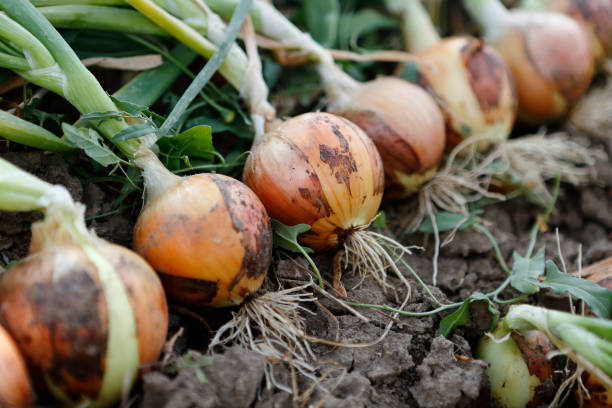$10 - 2 day local delivery fee on Pet orders less than $75

Russell Gardening Tips: Planting Onions
The start of the new year is also the best time for planting onions. Onions always start off the gardening season every year— Russell Feed will have onion sets available in stores in early January.

Here are some tips from the experts at Dixondale farm about planting onions:
Soil Preparation
Onions require full sun and good soil drainage. Choose a location that gets plenty of direct sun. Onions grow best on raised beds or raised rows at least 4″ high and 20″ wide. The soil should be loose and crumbly. If it’s compacted, work in compost to improve aeration and drainage.
To stop weeds for up to six weeks, rake a pre-emergent herbicide, such as corn gluten meal, into the top inch of soil before you plant. Don’t worry, the herbicide will not affect the onion plant roots.
Soil Type
It’s helpful to know whether your soil is acid (pH below 7.0) or alkaline (pH above 7.0). Onions prefer soil with a pH between 6.2 and 6.8. Your agricultural extension service can test your soil for you. For soil testing info, contact Tarrant County AgriLife Extension Service at 817-884-1945.
If your soil is too acidic, mix in ground limestone. If it’s too alkaline, add peat moss to the soil.
Planting Onions
Plant your onions 4 to 6 weeks before the last estimated spring freeze. (Average last frost or freeze for Tarrant County is around March 20th.) For the best growth and yield, onions need fertilizer right from the start. Use a fertilizer with the middle number higher than the other two, such as 10-20-10.
- Dig a trench that’s 4″ deep and 4″ wide. Sprinkle ½ cup fertilizer per 10 linear feet of row. Cover the fertilizer with 2″ of soil.
- Plant the onions 6″ from the edge of the trench on both sides of the trench. DO NOT plant the onions in the trench! Leave a 2″ margin between the onions and the outside edge of the bed.
- Plant the onions 1″ deep and no deeper, as this will inhibit their ability to bulb.
If you want the onions to grow to maturity, space them 4″ apart. If you prefer to harvest some earlier as green onions, space them 2″ apart and pull every other onion during the growing season, leaving the rest to grow to maturity.
When planting several rows of onions, leave 16″ between the outside edge of one bed, and the outside edge of the next. The spacing from the center of one fertilizer trench to the center of the next should be 36″.
Water, Fertilize, and Weed
The better care your onions receive during the growing season, the more likely you’ll have a bountiful harvest.
Water thoroughly after planting, and regularly thereafter. Onions have shallow roots, so don’t let the soil at the base of the plants become dry and cracked. Overwatering is equally problematic. If leaves develop a yellow tinge, cut back on watering. The closer to harvest time, the greater the need for water. However, when the onion tops start falling over, stop watering and let the soil dry out before harvesting.
Nutritional needs are different during the growing season. Every 2 to 3 weeks after planting, fertilize with ammonium sulfate (21-0-0) in alkaline soils, or calcium nitrate (15.5-0-0) in acidic soils. Sprinkle it on top of the original fertilizer strip at the rate of ½ cup per 10 feet of row. Water the onions after every application. Stop fertilizing when the onions start to bulb.
Controlling weeds is critical to prevent competition for nutrients. An application of corn gluten meal raked into the top inch of soil every six weeks during the growing season will prevent weeds from returning. Mulching with a light layer of straw will help control weeds and preserve moisture. Be sure to push the straw back when the plants start to bulb so they’ll cure properly.
Bulbing
When the ground starts to crack as the onions push the soil away, the bulbing process has begun. Stop fertilizing at this point.
Harvest, Curing and Storing
Proper treatment at harvest maximizes the amount of time you’ll be able to store your onions.
When the tops of the onions turn brown or yellow and fall over, it’s time to harvest. Ideally, the plant will have about 13 leaves at this point. Pull the onions early in the morning on a sunny day. Dry the onions in the sun for two days. To prevent sunscald, lay the tops of one row over the bulbs of another.
How long your onions will keep depends on how you treat them after harvest. They must be dried thoroughly to avoid problems with rot. If left outside when the weather is dry, this will take two or three days. The entire neck (where the leaves meet the bulb) should be dry, all the way to the surface of the onion, and shouldn’t “slide” when you pinch it. The skin will take on a uniform texture and color. If rain is expected, you’ll need to dry your onions indoors. Spread them out in a well-ventilated area with room to breathe. Drying indoors may take longer than outdoors.
Once the onions are thoroughly dry, clip the roots and cut back the tops to one inch. Now they are ready to eat.
Storing
Store onions in a cool, dry, well-ventilated location, such as a garage or cellar. Place them in mesh bags or netting to permit airflow. Periodically check for any soft onions, and remove them to avoid deterioration of the others. As a general rule, sweeter onions don’t store as long as more pungent ones, so use the sweeter onions first.
Visit Russell Feed stores for onion bulb sets, herbicides such as Corn Gluten Meal and fertilizers and get your spring onion harvest off to a growing start!


Leave a comment